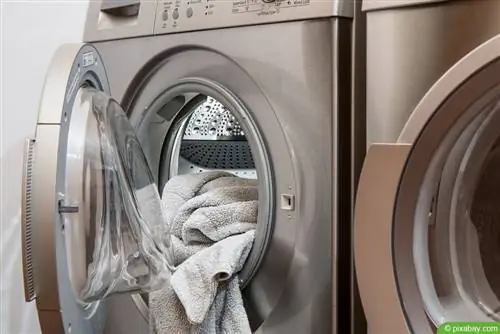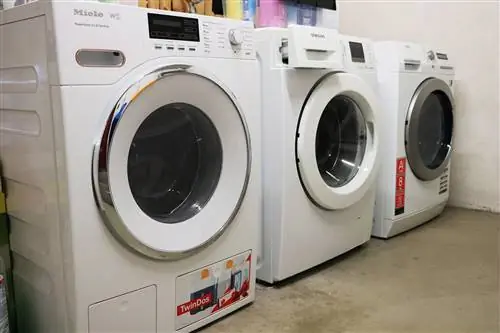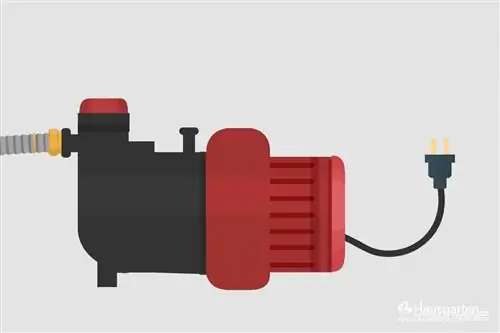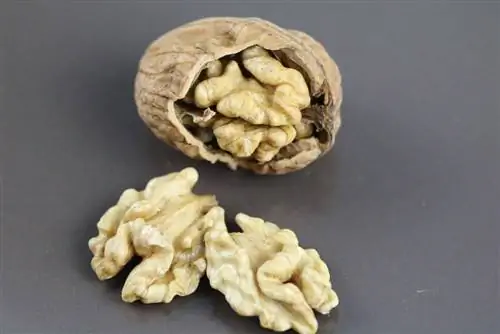- Author admin [email protected].
- Public 2023-12-17 03:39.
- Last modified 2025-01-24 12:45.
If your washing machine has problems with the drain or inlet, it can no longer wash efficiently. Fortunately, there are effective and quick solutions for individual problems.
Inflow disruptions: 3 causes
The most common cause of supply problems is a turned off water supply. Therefore, first check whether the tap on your washing machine is turned on so that water can flow into the device. Only then should you use one of the solutions below.
Low amount of water
If there is not enough water available, the individual programs cannot be run effectively. The result is dirty laundry that has barely been cleaned. This is caused by a clogged or damaged shut-off valve. You can determine this problem using the so-called bucket test:
- Disconnect the washing machine from the power supply
- Dismantle the inlet hose including Aquastop
- Hold bucket under tap
- Use 5 l or 10 l bucket
- Turn the tap on completely
- Measuring time
Ideally, up to 20 liters per minute flow through the inlet tap. You can determine the exact time using the bucket test. A 5 liter bucket should be completely filled after 15 seconds, a 10 liter bucket after 30 seconds. If this is the case, the small amount of water is not caused by the inlet tap. If this time is not reached, there will be problems with the shut-off valve. Contact a professional to have the valve checked.
Note:
After opening the faucet, turn it back half a turn if it is an old model. With this step you prevent the inlet tap from getting stuck, which in turn could limit its function.
Inlet strainer clogged
The inlet strainer sits at the end of the water-carrying hose and prevents deposits or foreign bodies from getting into the machine. This can cause it to become clogged. To check the strainer, remove the inlet hose from the machine. Locate the strainer and carefully pull it out of the machine using pliers. Check for possible debris or contamination. It is then cleaned like an aerator (aerator on the tap):
- rinse under running water
- Soak in vinegar for limescale deposits
- Flush the hose
- Assemble the hose and strainer
Check the dispenser compartment
The dispenser compartment could also be the cause of the problem. This is the chamber in which the detergent drawer sits. Pull out the detergent drawer and check the chamber for debris and dirt. Remove detergent residue with a brush and water, while limescale deposits are treated with vinegar or citric acid. After cleaning, reinsert the detergent drawer and start a short program without detergent or laundry. Pull the drawer out a crack and check the water flow. If the water only trickles or is slow, one of the following components is damaged:
- Solenoid valve
- Aquastop
You can replace the Aquastop yourself by purchasing a new hose with the component. If that still doesn't help, you need to have an expert check the solenoid valve.
Tip:
If, on the other hand, water gets into the machine without any problems, but it indicates a problem with the inlet, the air trap is probably clogged or the pressure can is defective. If this is the case, you should consult a professional as these problems cannot be solved without the necessary know-how.
Processing disorders: 4 causes
If there are drainage problems, the water can no longer be drained out of the drum. It remains in the machine even after spinning. The result is dripping wet laundry that is even too heavy to hang up.
Tip:
If you are unlucky, the washing machine no longer drains the water due to faulty electronics. Be sure to contact a professional about this problem.
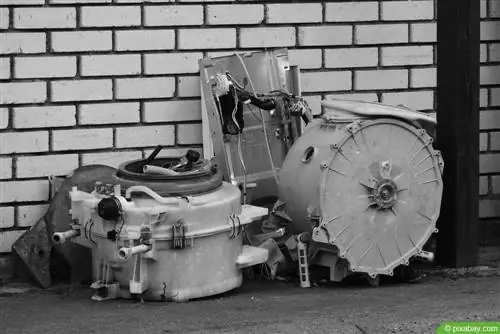
Clogged lint filter
The lint filter should be emptied and cleaned at regular intervals to ensure trouble-free operation. As soon as the water does not drain, you should first check the lint filter. Follow these points to get it working again:
- Locate the flap of the lint filter
- located in the front of the machine
- Can be pry open with a screwdriver
- place a shallow tub or bowl under the machine
- Open the lint filter
- Water will flow out of the sieve
- Pull out the sieve completely
- Remove foreign bodies, hair and lint
- Clean the sieve under running water
- use high water pressure and brush
- Also check the opening of the sieve
- clean if necessary
- Let the lint filter dry
- reinsert
- Close flap
- Conduct a test run
Clogged drain hose
As with the inlet hose, it can happen that the drain hose is clogged. Disassemble the hose and rinse it well. Lint, hair and foreign bodies often collect in the hose and prevent the water from draining.
Defective drain pump
It becomes problematic if the drain pump in the device is defective. This is not noticeable from the outside, but you can listen for a rattling or crashing noise when the water is sucked out. If this is the case, the drain pump is definitely damaged. However, the creation of noise is not always the case. If cleaning the drain hose and lint filter doesn't help, have a professional check the pump and repair or replace it as necessary.
V-belt problems
Sometimes the process can be disrupted due to a slipped or broken V-belt. The V-belt ensures that the drum is set in motion. Without the V-belt, the drum can no longer be moved, which makes it difficult for the water to drain away. If the solutions mentioned so far have not helped, contact a specialist company to have the V-belt checked and replaced if necessary.

